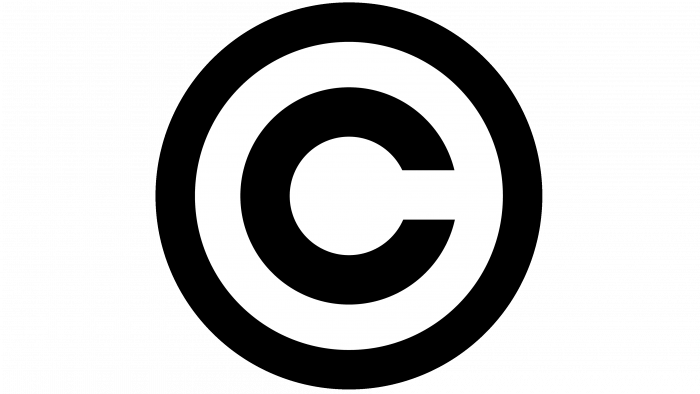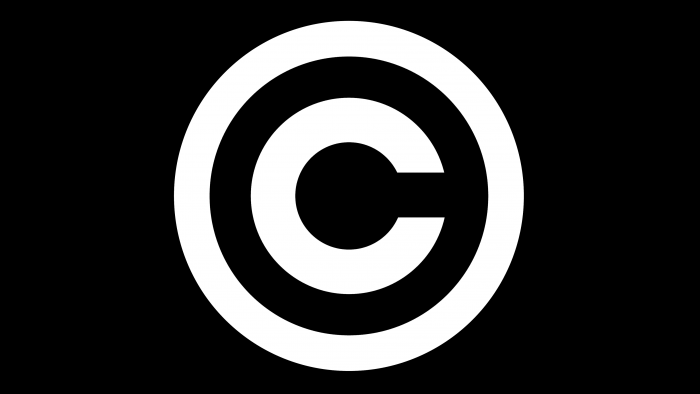The Copyright logo informs about the reliable protection of the interests of the authors of products and works. The emblem surrounds the client’s property like a wall. Copying is completely excluded. Signs promise strict adherence to rules and laws.
Copyright: Brand overview
Meaning and History
Copyright protects the intangible creations of the intellect. Its owners are free to reproduce and copy their creative work—usually for a limited period. The duration of copyright depends on the life span of the person who created the work and expires several decades after his death.
The copyright notice uses a special symbol resembling a large “C” inside a ring. Until 1989, this mark was mandatory: US law required copyright holders to affix it next to intellectual property, indicating the year the work was recorded on the tangible medium and the author’s name.
What is Copyright?
Copyright is a copyright symbol with a protection function. It is intended to indicate intellectual property products. The mark is formed from the first letter of the word “copyright” surrounded by a ring.
The Berne Convention was adopted in 1989. It allowed the use of © only at will because the creators of the intellectual property began to receive copyright automatically. But it should be borne in mind that the presence of a “C” in the circle helps to prove the damage done if the case goes to court.
The original symbol was introduced in 1952 following the adoption of the Universal Copyright Convention. However, it existed before: the © sign was first mentioned in the Copyright Act 1909. Until 1909, legislation allowed copyright holders to use only the word “Copyright” or its abbreviated version “Copr.”. The artists did not like this requirement: they wanted to indicate their name on the picture without unnecessary text. The government made concessions to them and replaced the long inscriptions with a capital letter “C” inside the ring.
The Copyright mark cannot be called a full-fledged emblem because it fulfills a legal function and does not belong to any particular organization. It is an abbreviation for “Copyright,” placed inside a white circle with a black outline. To reproduce it, there is a special character that has the Unicode U + 00A9. Sometimes, © is replaced with a simple “C” in parentheses. This option (C) arose because there was no corresponding sign on the typewriters. Alternative versions with inscriptions are also allowed: the abbreviation “Copr.” or the word “Copyright” without abbreviations.
Copyright: Interesting Facts
Copyright is a legal concept that helps protect original works like books, music, and art. It allows creators to control and benefit from their creations, making it a crucial part of intellectual property law.
- Early Beginnings: Copyright began with Britain’s Statute of Anne in 1710, which gave authors exclusive rights for a set period and set the stage for modern copyright laws.
- Recognizing Copyright: The © symbol, or the word “Copyright” with the year and owner’s name, indicates copyright protection.
- Berne Convention: This international agreement, which has existed since 1886, has aimed to protect creators’ rights worldwide, including in over 170 countries.
- How Long It Lasts: In the U.S., copyright for works made after January 1, 1978, lasts the author’s life plus 70 years. For corporate works, it’s 95 years from publication or 120 years from creation, whichever is shorter.
- The First Copyrighted Work: “The Tickle Me” by Dr. Sacheverell was the first to be copyrighted under the Statute of Anne in 1710.
- Fair Use: This principle allows copyrighted material to be used without permission for specific reasons, like education or commentary.
- Digital Age Adaptation: The DMCA of 1998 updated copyright laws for the digital era, addressing anti-piracy measures and providing protections for internet service providers.
- Global Differences: Copyright laws vary by country, even among Berne Convention signatories, making international enforcement challenging.
- Economic Significance: Copyright-intensive industries are vital to economies, contributing to GDP, employment, and trade, highlighting the need for robust copyright protection.
- Public Domain: Works not under copyright protection or whose copyright has expired are in the public domain, freely usable by anyone, fostering cultural exchange and innovation.
Copyright protects creators’ rights while supporting economic growth, cultural exchange, and innovation by ensuring creators can profit from and control the use of their works.
Font and Colors
The letter “C” in the classic version is bold, capitalized, and has no serifs. It resembles an open ring and is the same thickness as the width of the circular frame. However, the Unicode Copyright symbol (U + 00A9) looks very different: a long serif is at the top of the “C,” and the arc-shaped line is tapering on both sides. As such, the letter looks like the capital “C” in Times New Roman.
The copyright mark is often black, with elements on a white background. However, the color can change arbitrarily since it is used in different visual contexts. There are no rules that limit the palette. The main thing is that the © symbol is visible.
FAQ
What is the C circle symbol?
The circle symbol “C,” written as ©, signifies copyright protection. This shows that the work is protected by copyright law and that the copyright holder has special rights. These rights include reproducing the work, distributing copies, publicly performing the work, publicly displaying the work, and creating derivative works.
The © symbol means “copyright” from the Latin word “copiere,” which means “to copy.” If you see this symbol, the work is protected by copyright law. The copyright holder has exclusive rights to the material. It can be found in various works, including books, articles, music, films, websites, software, and artistic works such as paintings and sculptures. Using this symbol is a way to protect intellectual property for authors and brands.
Is the copyright symbol C or R?
The copyright symbol is the letter “C” inside a circle, written as ©. It differs from the registered trademark symbol, an “R” inside a circle, written as ®. Both symbols protect various forms of intellectual property.
The © symbol indicates copyright protection. This shows that the work is protected by copyright law, giving the copyright holder exclusive rights to use, distribute, and license the material.
The ® symbol means “registered trademark.” It shows that a trademark has been registered with the appropriate office. This symbol is used for brand names, logos, slogans, and product names.
How do I type a copyright symbol?
Depending on your device and operating system, you can enter the copyright symbol (©) differently. Here are ways to enter the © character on different platforms:
- On Windows: Use the Alt code method. First, enable Num Lock. Then, while holding down the Alt key, type 0169 on the numeric keypad and release the Alt key. This will insert a © symbol.
- On a Mac: Use the keyboard shortcut by pressing Option + G. This will insert the © symbol.
- In Microsoft Word: Go to the Insert tab, click Symbol, then More Symbols, find the © symbol, and click Insert.
- For HTML: Use the HTML entity © to enter the © symbol. This will appear as © on the web page.
- On mobile devices:
- For iOS (iPhone/iPad): Open your keyboard, press and hold the C key, and select the © symbol from the pop-up menu.
- For Android: Open your keyboard, press the “?123” key to switch to the symbol keyboard, then press the “~{” key to see more symbols. Find and tap the © symbol.
- On Linux: Use Unicode. Press Ctrl + Shift + U, type 00A9, and press Enter or Spacebar to insert the © symbol.
How do you type C in a circle?
Using Unicode character codes, you can enter the letter “C” in a circular character. The exact method of typing the letter “C” in a circle varies depending on your operating system and device.
Can I put a copyright symbol on my logo?
Yes, you can place a copyright symbol on your logo if it is an original work and does not infringe on anyone else’s copyright. Your logo should be a unique design you or your brand created from scratch. Copyright applies to specific designs, including graphics, text, and colors, as long as they are arranged uniquely.
Placing the © symbol in your logo lets others know you claim exclusive rights to that design. This can discourage others from copying your logo and support your dispute claim by showing that you have claimed copyright. When placing the © symbol on your logo, indicate the year of creation and the copyright holder’s name.
Is the copyright logo illegal?
The copyright symbol is not illegal. This freely available symbol indicates that a work is protected by copyright. It helps notify the public of your copyright claim and may provide legal benefits in protecting your intellectual property. By using the copyright symbol correctly, you can protect your creative works.





